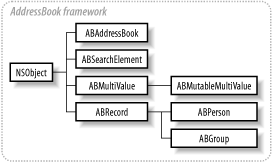AddressBook
The AddressBook framework was released with Mac OS X 10.2. This framework provides a consistent, system-wide interface to a user’s database of personal contacts. Using the AddressBook framework, applications can access the same information used in Apple’s own suite of personal information management applications, including Mail, Address Book, iChat, iCal, and iSync. Figure 8-1 shows the AddressBook framework’s class hierarchy.
 |
ABAddressBook is the main class representing the
contacts database. The ABAddressBook class
provides access to a collection of records, of two types: people and
groups, represented by the classes ABPerson and
ABGroup. ABPerson and
ABGroup inherit from the class
ABRecord
,
as shown in Figure 8-1. Records are like souped-up
dictionaries that store information in property-value pairs (similar
to NSDictionary’s key-value
pairs, but ABRecord properties provide additional
functionality).
Both people and group objects store properties, but they are not the
same set of properties since a group does not share the
characteristics of an individual. To retrieve the value of a property
associated with a record, invoke the method
valueForProperty: in the
ABRecord object in question. To store a value for
a record’s property, use the method
setValue:forProperty:.
ABAddressBook provides methods that access records ...
Get Cocoa in a Nutshell now with the O’Reilly learning platform.
O’Reilly members experience books, live events, courses curated by job role, and more from O’Reilly and nearly 200 top publishers.

